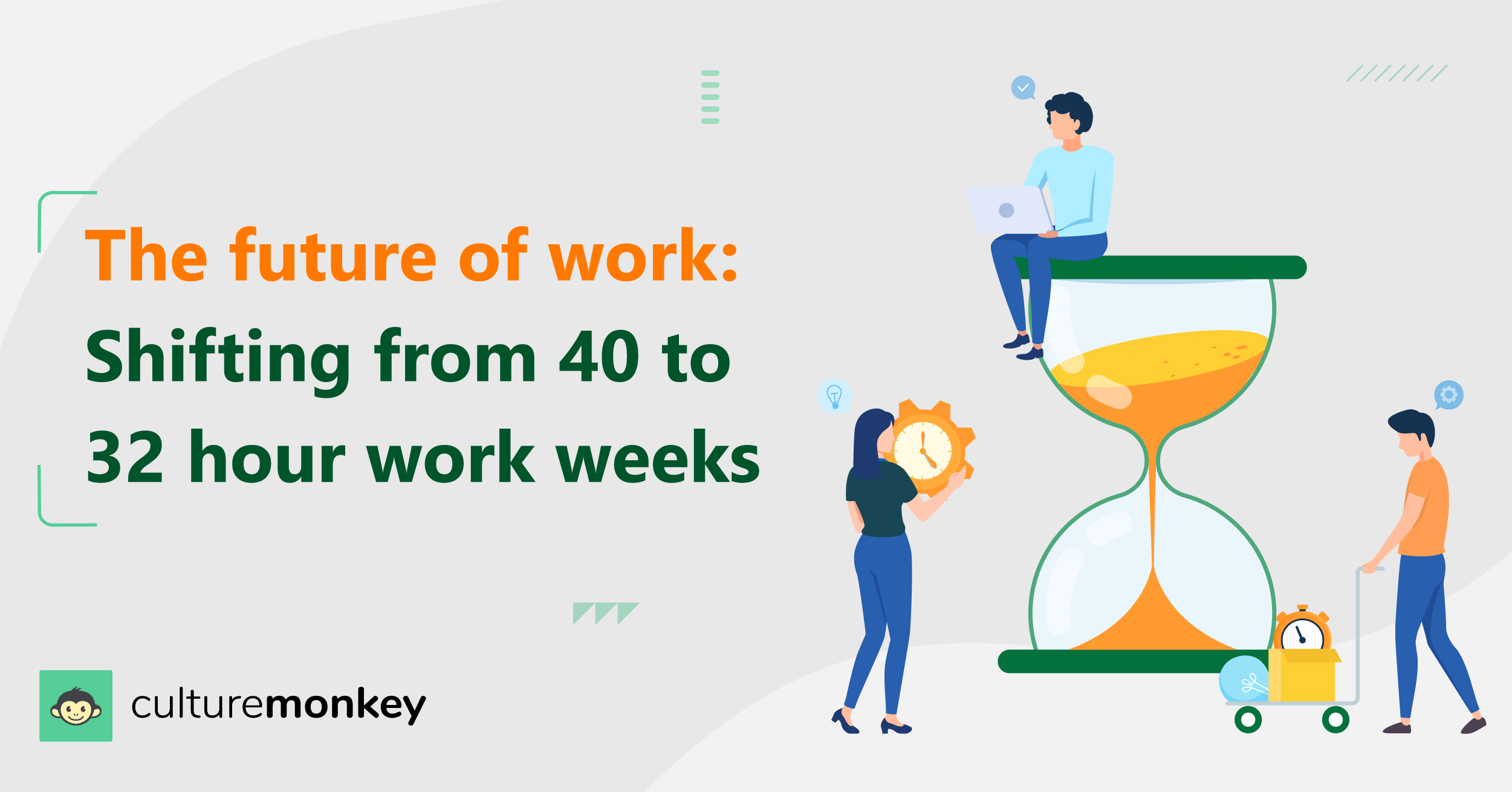The future of work: Shifting from 40 to 32 hour work weeks for better productivity and employee engagement

Table of contents:
1. The history of 40-hour workweek
2. Is 40-hour work week really the magic number for today’s employees?
3. The negative side of working for more than 40 hours a week
4. The new trend of 32 hour week: Reducing hours doesn’t reduce work!
5. How does choosing employee work hours impact employee engagement?
5.1 Employee productivity
5.2 Employee work-life balance
5.3 Employee mental wellness
5.4 Employee satisfaction
6. Design the perfect workweek model keeping employee sentiment in mind
Imagine a world where each and every employee has a real work-life balance and job satisfaction? What do you see? We see the end of the 40-hour workweek. This means no more strict punch-in and-out time frames and no more 9-5 days. A world where working when you want, how you want is normalized. For an employee, this would be a utopian fantasy, but is it necessarily a reason to panic for the employers? We believe it can be a win-win for both parties.
But the system is still a little far from giving this freedom of choice to every existing employee. Which makes us wonder who decided the ideal number of hours for employees? What made them decide that 40 hours is productive enough to accomplish tasks in general? In the next section of the blog, you will understand how and where this work model was enacted.

The history of 40-hour workweek:
The concept of a 40-hour workweek goes back to the 19th century. It started in 1817, during the Industrial Revolution when labor unions and activists revolted for better working conditions. People were made to work for enormous amounts of hours which ranged from 80 to 100 hours per week. Later in 1926, Henry Ford established the 40-hour workweek rule after great research which proved that working more hours yielded a very minimal increase in productivity that too for a very short time.
Later in 1938, Congress accepted the theory and passed the Fair Labor Standards Act which required employers to pay overtime if they made employees work for more than 44 hours which was later reduced to 40 hours a week. And finally, in 1940, the 40-hour workweek became U.S. law.

Is 40-hour work week really the magic number for today’s employees?
Research shows that employee productivity falls sharply after they have been made to work for a 50-hour work-week, and falls off the cliff after it crosses the 55 hours mark.
Keeping history aside, in today’s current scenario, there’s no research that proves if there is an increase in productivity or imaginative problem-solving with more zombie-like hours. In fact, research shows that employees are only productive for 2 hours and 23 minutes in a day. Most of their workdays are consumed by attending unnecessary meetings or responding to e-mail requests.
And with the pandemic and remote work in place, employees have proven to be more productive when they have ultimate flexibility, without the constant need to track work hours. This brings us to the conclusion that employers should only focus on outputs and not worry about the number of hours an employee works as hours are the wrong focus area for managers.
The negative side of working for more than 40 hours a week:

Long working hours not only affect productivity but also impact the health and well-being of employees. Health organizations and researchers proved:
- Working for more than 10 hours per day increases cardiovascular risks for employees.
- The risk of slipping into depression increases if employees work more than 10 hours of overtime in a week.
- Alcohol and tobacco use increase when employees work more than 40 hours a week.
- Relationship and work-life problems increase by about 10% when employees work more than 50 hours a week and by 30% if they work for more than 60 hours.
- Overall stress related to extra working hours can disturb hormone levels, sleep, mood, memory, appetite, blood pressure, and more.
The new trend of 32 hour week: Reducing hours doesn’t reduce work!
A lot of companies have got the concept of 4 day work week all wrong. Imagine employees working for 8 hours 5 days and employees working for 10 hours 4 days? Is there a difference in the working hours? Does it favour the employees in any circumstance? The answer is no!
Companies willing to try out the 4 day work week need to understand that it’s the number of hours that matter too. 4 day work week or 32 hours work week means having a four-day work week for 8 hours each day. And, so far we have learnt that extra hours is not equal to extra productivity, so, why not look at the results for yourself by reducing the working hours for your employees? Companies like Perpetual Guardian and Microsoft Japan who have tried out 32 hour work week with their employees report some great results from this experiment as they witnessed:
- Employees were more active throughout the week
- 24% increase in work-life balance
- Employees' creativity levels increased
- Employee absenteeism reduced
63% of businesses found it easier to attract and retain talent with a 4 day work week.

With the 32-hour workweek concept, more and more companies are acknowledging that the new trick to attract and retain employees is by giving them a quality of life and that too at reduced-hour. Leaders should create productivity-focused ecosystems that will act as a vehicle to give organizations a competitive edge.
So, the idea is pretty simple and straightforward. Four day work week requires employees to work 80% of the time for 100% of the salary while maintaining 100% productivity.
No doubt, it’s impressive to live in an era where leaders are open to testing and implementing new standard workplace structures while offering their employees flexible work options. But, it’s imperative to understand that in the end, organizations should not blindly follow trends as there is no one size fits all solution and every business has different needs to address. Leaders must adopt practices that best align with the needs of their organization.
78% of employees with 4-day work weeks are happier and less stressed.
How does choosing employee work hours impact employee engagement?
#1 Employee productivity:
Companies must develop a result-oriented approach for employees at all levels. Their work hours should not merely mean fulfilling the specific amount of hours and time expected. But, leaders should create an environment of trust with the flexibility to complete their work in the best time frame possible. The employee must be recognized and rewarded for finishing their tasks earlier than expected.

With less time available (in the case of 32 hour work week), it’s possible for employees to prioritize and focus on the critical tasks without any procrastination while yielding a higher quality result.
# 2 Employee work-life balance
People are craving personal time more than ever after the pandemic. Ever since people have realized the value of relationships and time with loved ones, they expect employers to help them maintain a work-life balance by letting them live life on their terms. And it’s true that increased workplace flexibility is not only the need of the hour but highly effective for employees.

For Perpetual Guardian, the sense of work-life balance amongst employees went from 54% to 78% and team engagement increased by 20% on average.
The end result with fewer or flexible work hours is a workforce that’s empowered, energetic, and committed.
# 3 Employee mental wellness
By now we know long working hours create work-life imbalance for employees and are majorly a direct cause of stress. Stress triggered by unusual working hours profoundly impacts employees' mental and physical health. It leads to hypertension, sleep fatigue, and depression causing burnout, and absenteeism with an overall decrease in the quality of work.

Switching to the four-day, 32-hour week, by Perpetual decreased stress levels by 7% while subsiding the perception of workload on employees. This directly leads to happier and more engaged employees.
Giving employees the flexibility to choose their own working hours or experimenting with a 32-hour work week model will give them more time to relax and decompress. They could indulge in activities they like or learn new skills to help themselves cope with stress. Extra family time and one lesser day of commuting also go a long way in maintaining employee mental wellness.
# 4 Employee satisfaction
Employees want to feel valued and by showcasing that organizations care for their employees and their needs, they create a more committed and engaged workforce. Showcase that you can fundamentally change the way you do business for your employees and create an ecosystem of trust. If employees have enough autonomy, it will directly lead to a greater sense of belonging increasing employee retention rates.

Actions and changes like these create a more dedicated workforce; a workforce who is willing to go out of their way to bring success to the company. This is what truly turns satisfied employees into company advocates who believe in and trust your company's mission.
A four-day workweek shows an increase in overall life satisfaction by 5% in employees.
We are confident that choosing a 32 hours work week or less will bring positive results. But, it’s not fair to just look at one side of the picture. Some roles and positions could be tricky and implementing lower work hours might not be possible. Nevertheless, the key to success is to recognize and reward employees for results and not for the time they have put in.
Design the perfect workweek model keeping employee sentiment in mind
Research has definitely proved that the effects of working for 50 hours a week are bleak and anything over 40 hours a workweek drops employee productivity overall. But is a 40-hour work week the formula for happy and productive employees, or is it the opposite? Is it outdated and a contributing factor to low national engagement and productivity levels?

HR leaders must carry the torch for this issue and find the best suitable work model for all their employees. Its imperative for them to continuously listen through employee engagement and satisfaction surveys to know what the employees actually want from the organization in terms of work flexibility, support and working hours. Taking their perspective on a policy that will impact the employees in the end is crucial. Lets managers see what their employees value the most through manager dashboards and take swift actions before it turns obsolete.
If you want to create a culture of outstanding results strive to encourage employees to work less and achieve more. Let's end the 9-5 exertion of 40+ hours per week! Let's build workplaces together where full-time hours per week are 32 hours or less and the employees have complete flexibility to choose their work models.



